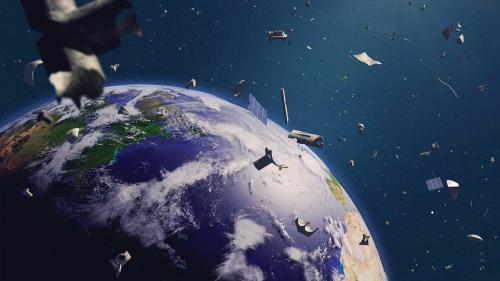Over the past 60 years, we have sent into Earth orbit 15 000 satellites, rocket stages and other objects. According to the European Space Authority (ESA), there are 130 million pieces of human-generated debris smaller than one centimetre and 32 000 larger items of space junk, all travelling at great speed. These small fragments have resulted from satellite–satellite and satellite–debris collisions over the past six decades. There are now about 9600 satellites in orbit with 6800 of these being defunct. That number of orbiting satellites is increasing massively, with the recent ongoing addition of so-called ‘mega-constellations’ of satellites by private corporations such as SpaceX and Amazon. These mega-constellations offer the great benefit of connectivity for poorer countries and communities that otherwise would not have access to the internet infrastructure. They also extend the future possibility of involvement in the huge space-sector economic growth for such disadvantaged populations. An unusual example of such a benefit is the provision of SpaceX internet services by Elon Musk companies to Ukraine while it is resisting the invasion by Russia.
These great benefits come with an increasing risk as the overfull orbit with its associated collisions behaves like a grinder of satellites. With the expectation that there will be up to 12 000 SpaceX satellites in the future, the risk is that at some point any new satellites added to orbit will be destroyed or damaged by increasing numbers of debris collisions. This would mean that access to the many strategic advantages of the global internet to humanity could be extinguished, including GPS navigation, weather, climate change monitoring, security, science and entertainment. This risk has been given the name the Kessler syndrome.
The key to avoiding such a disaster is to develop approaches to remove dead satellites. However, while a series of possible removal strategies have been conceptualised by space agencies, no single item of space debris has yet been intentionally removed from orbit. ESA has a project with a timeline of 2025 that involves a chaser satellite attaching itself firmly via a harpoon to a large rocket-stage debris target. Robotic arms will be used to secure the target to the chaser and any damage fragments retained by a net. The chaser plus target is then programmed to carry both as a unified unit into Earth’s atmosphere to safely burn up. The company Airbus is involved in developing harpoon capture and removal technologies. Other removal technologies involve lasers in orbit or a laser on a land base. Small debris items can be ablated by laser and the directional pressure of ablation vapour propels the small item either into the atmosphere or into deep space.
The materials commonly used in satellites include approved light metals, polymers and carbon composites. During the disintegration of a dead satellite re-entering the atmosphere, the properties of these materials are important in minimising the quantity and nature of debris reaching Earth’s surface. The recent case of a large Chinese rocket stage falling uncontrollably to Earth has caused international safety concerns among space agencies and media because of the possibility of it landing in a populated zone. Uncertainties about the materials used in the rocket stage have added to these international concerns.
At least one NASA-approved polymer has a chlorofluorocarbon mer unit. This material is related to the chlorofluorocarbon monomer refrigerants that were implicated decades ago in the catalytic chain-decomposition of the ozone shield by photolytically generated chlorine atoms. Atmospheric burn-up of such a polymer associated with satellite re-entry could in principle release such catalytic chlorine atoms. At this stage, the extent to which this specialty polymer is used in space devices is not clear.
A concerning aspect of a connection between re-entry science and elevated carbon dioxide levels of the atmosphere from increasing human use of fossil fuels has been reported. Elevated atmospheric carbon dioxide levels increase the density of the lower atmosphere but decrease the density of the upper atmosphere, where the satellite burn-up mainly begins. This loss of upper atmosphere density has been measured at a surprising 20%. Further, the research group exploring this effect claims that the decrease in density could be much greater if carbon emissions continue to grow. The result would be that the ability of Earth’s upper atmosphere to capture dead satellites would be sharply reduced. This in turn would mean that this natural pathway of dead satellites moving out of orbit would be substantially reduced and so the number of dead satellites remaining in orbit much longer would progressively increase with time. Instead of an average satellite remaining in orbit for 15 years, it could continue to remain in orbit for several decades. The overall effect would cause the barrier to the addition of new critical satellites to arrive much sooner than previously projected.



